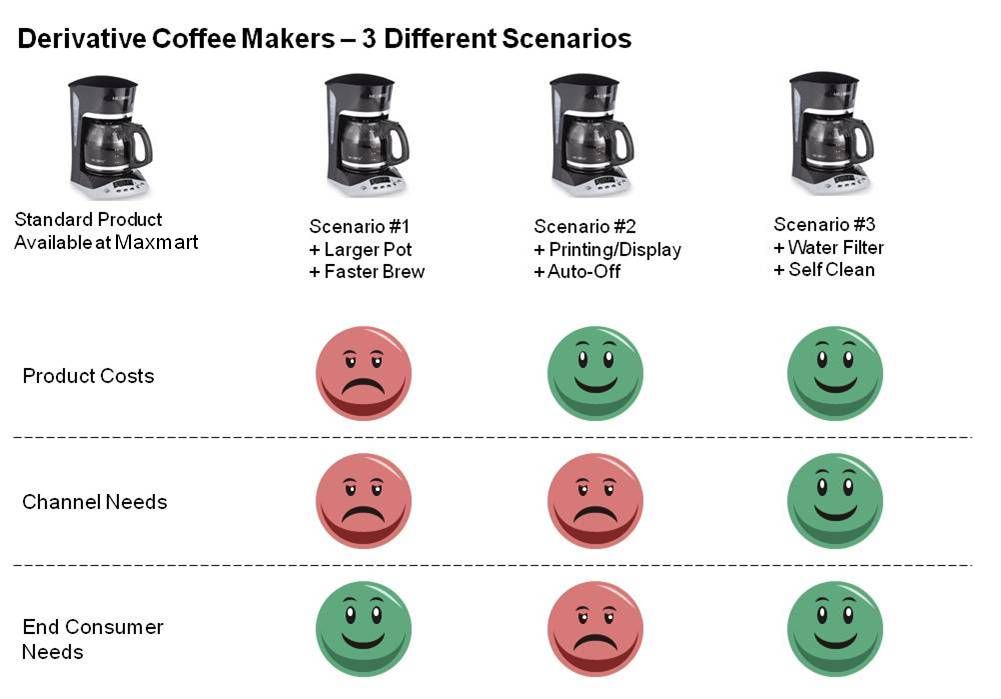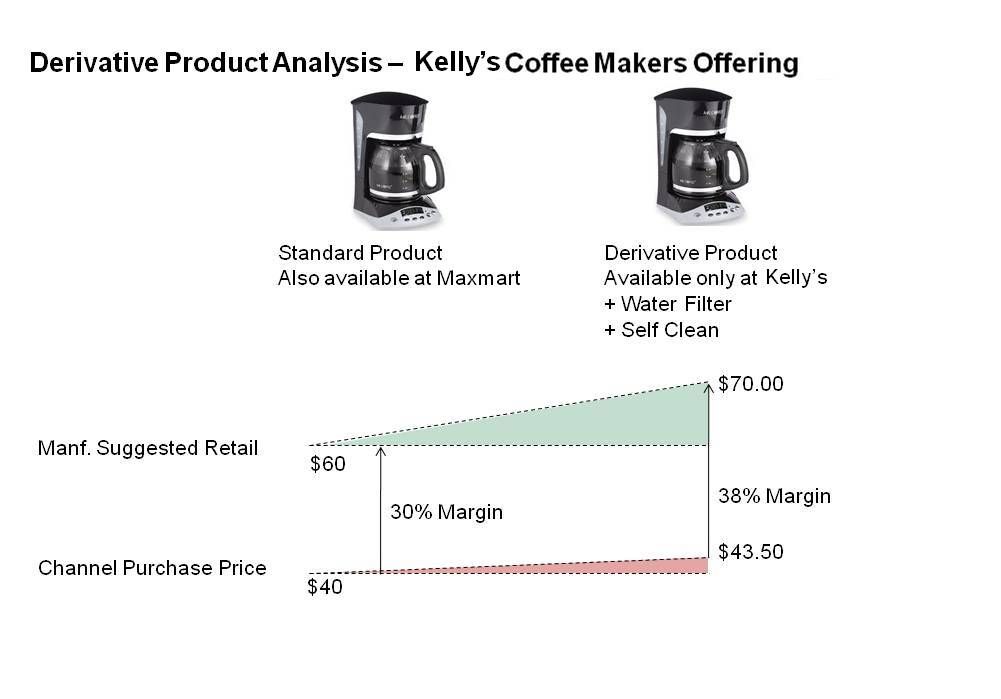NOTE: The following is a guest post from Chris Shanley.
If you want to submit your own guest post, click here for more information.
– –
Back in March 2010, this blog had a great post about the importance of differentiation. It is impossible to overestimate the importance of being different from your competition. But what about the times you need to be different from yourself?
This need to compete against one’s self occurs when you’re manufacturing the same product for sale in competing sales channels. No two channels are exactly the same and their needs can be as different as the customers they serve. The closest mega grocery store and the specialty wine shop down the street may both sell the same wine, but they would certainly claim to serve very different consumers.
One answer for manufacturers is derivatives. Creating slightly different versions of the core products specific to each channel can avoid the need for competing channels to use the same product.
There are few roles that require so many of the specialized skills of a product manager as creating derivative products within a current product line. As in the December 20th post on market authority, developing a derivative strategy requires keen understanding of markets, products, competition, buyers/users, and connections.
In defining and creating successful derivatives a product manager must address all three of the following:
- Drivers of product costs
- Needs of the specific sales channels
- Needs of the end consumer
Failure to address all three will at best result in a product that does not eliminate the conflict and at worst result in losing sales channels and growth potential.
A Hypothetical Example: Coffee Makers
These ideas are best illustrated through an example. Let’s use a coffee maker as the product. Let’s also assume that one channel is a “big box” retailer (Maxmart here just for the sake of argument) and the other is a smaller retailer with only 5 locations in Southern California. We’ll call them Kelly’s for our example.
The situation: Kelly’s is one of a group of retailers that is complaining that they just can’t compete with the prices of the exact same coffee maker at Maxmart. You can’t afford to lose all the business that you do at similar retailers.
First, let’s start by understanding the differences between Maxmart and Kelly’s. Each has a different strategy in the goal to sell more coffee makers. So what are the differences here?
|
Maxmart |
Kelly’s |
|
| Target Volume |
1 Million |
1,500 |
| Store Environment |
|
|
| Sales Staff |
|
|
| Price Strategy |
|
|
| Margin Requirement |
40% |
30% |
The problems in managing such diverse channels with the exact same product are immediately clear. With an annual purchase of 1 million units, of course Maxmart can demand 40% margin! Even if a consumer shops at Kelly’s, they will immediately realize, “Hey, I can get the exact same one at Maxmart for $30 less! Yes, the store was really nice and the sales staff was great, but in the end it made me really want a product I could get down the street for far less.”
So, now let’s look at the specifics of the product. As this coffee maker is already in production, it won’t be possible to change certain things. For example, you can’t sell it with a larger pot because that would mean finding a supplier for a new pot, finding a more powerful heating element to keep a larger pot warm, etc. Not to mention that to affect these changes would take so much time, that by the time you made them and shipped it, Kelly’s would be out of business. Here is an overview of possible changes to the product and time and cost associated with each:
| Feature | Cost | Time |
| Larger Pot | $15/unit | 2 years |
| Faster Brew Times | $25/unit | 1 year |
| Improved water Filter | $3/unit | 8 months |
| Housing color | $0/unit | 6 months |
| Printing color/font | $0/unit | 6 months |
| Color of display | $0.50/unit | 6 months |
| Auto-off | $0/unit | 6 months |
| Self-clean | $0.50/unit | 8 months |
Finally, let’s not forget the needs of the customer. Just because you can add a larger pot, should you? Will it be the feature that keeps them in the store and purchasing there instead of from Maxmart? Let’s assume the appropriate research has been done and we know the key factors in the purchase process for the end consumer:
| Needs of the Consumer | Importance |
| Brew each pot faster | 5 |
| Brew larger pots of coffee | 5 |
| Better tasting coffee | 3 |
| Additional options | 3 |
| Design (Color/Materials) | 2 |
| Safety | 1 |
Using a 5-pt scale where 5=Most important and 1=Not important at all
Based on this information, let’s imagine three different scenarios:
- A derivative with a larger pot and faster brew times
- A derivative with new printing/display color and Auto-off feature (Addresses design and safety)
- A derivative with an improved water filter and a self-clean function (Addresses better tasting coffee and offers additional options)
Derivative 1 – At first glance, derivative #1 looks like a pretty good idea. But this amount of additional cost and the time it will take to execute make this less of an option. In fact, it’s not really a derivative strategy at all. The derivative should allow the channel to compete in the same price point. This product is really more of a step-up strategy. It means that the retailer has to go after an even smaller percentage of the market at higher prices.
Derivative 2 – If you were to work only with the engineers and developers you will end up with derivative #2. In just six months you have a product that looks different, and it can be sold at the same price and margin level as today. That’s great, but the features added are not enough to keep the customer in the store. Design and safety (the Auto-off feature) are the least interesting to the customer. They are not going to stay at Kelly’s and pay 10% more just for these features.
Derivative 3 – The last scenario offers the best of all worlds. In derivative #3, you have features that are interesting to the customer, features that have fairly low costs, and features that make this coffee maker truly different from the Maxmart version. This is the only solution that addresses the needs of all three parties.
(click to enlarge)
Derivative Selling Strategy
There is a twist that could make this even more successful– a move that a product manager can work with sales to implement. Since the features are so high on the “important to the customer,” scale, the value in the market place for these is even higher than the cost to implement them.
The additional cost of $3.50 in the market would actually mean a price of $4.55 higher. However, customers would expect to pay $10 more because they like the features so much. So the solution is this: on this derivative, increase Kelly’s margin by setting the retail price to the customer expectation but only increase Kelly’s cost by the actual cost. Now Kelly’s has a piece with something closer to Maxmart margin, is only slightly more costly, but includes features that are highly valued, and is clearly different from the “standard.”
If the customer now claims they can get the same one at Maxmart, the sales associate has two key features to point out that are not available there. If he feels he might still lose the sale, the associate offers to knock an additional $5 off the price “just for our special customers.” The key is that even when reducing the price by $5 for the customer, he will still make 33% on the coffee maker as opposed to the standard 30% on standard products!
In the meantime, Maxmart is just as satisfied with their product without the features because they can maintain their cost leadership. Even if the product had more features, they do not have the trained and qualified sales staff to explain and sell the value.
For makers of consumer durables or packaged goods, channel conflict is a good sign that the product is so popular that multiple sales channels want to sell it, but it will always be a threat to future growth when one channel does enough volume to demand higher margins. However, by understanding the product cost drivers, the needs of specific channels, and the needs of the end consumer product managers can create clever product derivative strategies that manage the conflict and drive growth.
Chris Shanley
—
Chris Shanley is a senior product manager with 7 years of experience in managing and marketing consumer goods and consumer durables for various product categories including home appliances and power tools. You can reach Chris via his email – [email protected].

